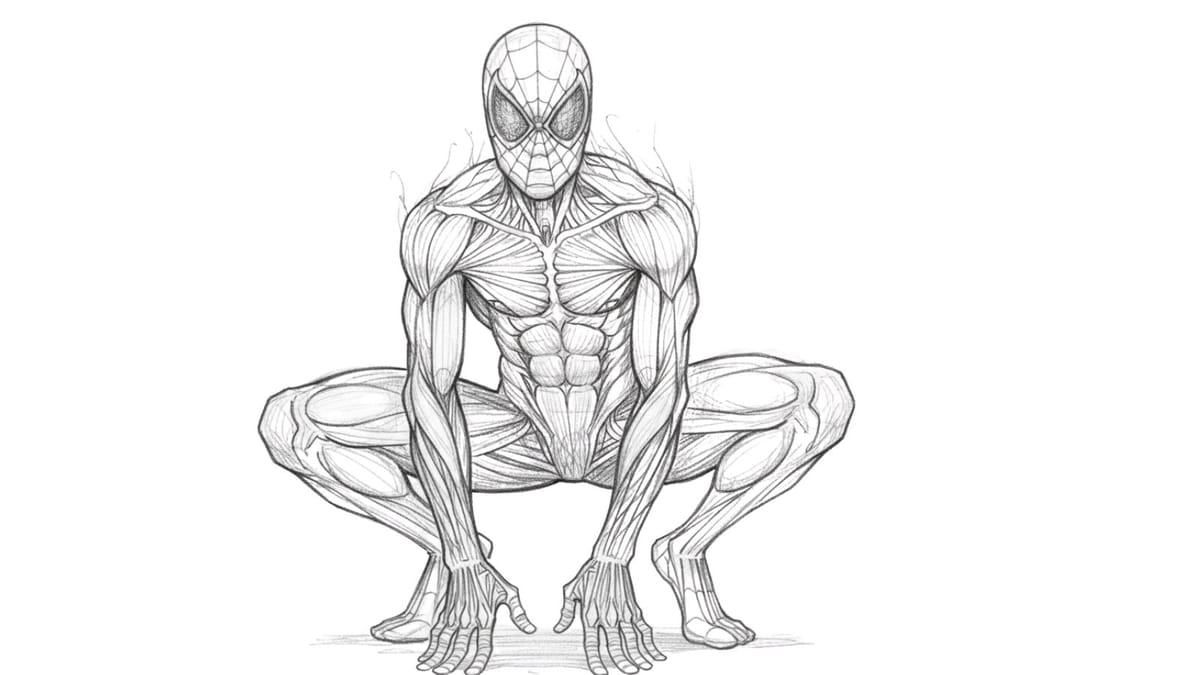Fascia: Your Body’s Hidden Web
The invisible web that quietly influences every note you play.

When it's healthy, your movements glide. When it tightens, you feel stuck.
Most guitarists obsess over finger speed and hand strength. They practice scales. They do exercises. They work on technique.
And yes, all that matters.
But beneath your skin, beneath all the muscles and tendons you're trying to strengthen and stretch, lies an invisible web that quietly influences every note you play.
This web is called fascia: a thin, fibrous connective tissue that wraps around every muscle, tendon, ligament, bone, and organ in your body.
When it's smooth and flexible, your movements glide effortlessly. You reach for a chord and your hand just... flows. No resistance. No grinding. No sense of fighting your own body.
But when fascia tightens or "glues down"- when it gets sticky and restricted, you feel stiff. Restricted. Sometimes even in pain.
And you can stretch and strengthen all you want, but if the fascia's stuck, you're not going anywhere.
In this post, I'm going to help you understand what fascia actually is, why it matters for musicians, and what you can do to keep it healthy so your body moves the way it's designed to.
What Is Fascia, and Why Should You Care?
Alright, so let's start with the basics.
Fascia is a continuous layer of connective tissue made mostly of collagen. It provides form and function to every part of your body. It's literally everywhere.
Think of it like this: fascia is the spiderweb woven through your muscles, bones, and organs.
It wraps around everything. It connects everything. It creates this three-dimensional network that holds your entire body together.
And here's the key: because fascia touches everything, any restriction in one area can create tension somewhere else.
That's not metaphor. That's anatomy.
Tight hips? That can tilt your pelvis. Which affects your spine. Which affects your shoulders. Which affects your neck. Which affects your arm position. Which affects your fretting hand.
It's all connected. The web doesn't have breaks in it. Tension travels.
So when you're dealing with chronic shoulder pain or wrist tightness or thumb ache, and you can't figure out why stretching and rest aren't helping... maybe the problem isn't where you think it is.
Maybe it's a fascial restriction somewhere upstream that's pulling on the whole system.
How Fascia Shapes Your Movement (And Why It Gets Stuck)
Unlike tendons — which connect muscle to bone — or ligaments — which connect bone to bone — fascia wraps around and stabilizes every structure.
Muscles, tendons, ligaments, bones, organs. Everything.
It holds muscle fibers together. It allows them to contract and stretch smoothly. It provides low-friction surfaces so tissues can glide past each other without catching or sticking.
When fascia is healthy, you feel fluid and mobile. Movement is easy. Effortless. Your body responds to what you're asking it to do without resistance.
When fascia is tight or inflamed, it restricts movement and can cause pain. It's like trying to move through honey instead of water. Everything feels harder. Stiffer. Like you're dragging weight that shouldn't be there.
Why Does Fascia Get Stuck?
A few reasons:
Repetitive movement without variety.
If you're doing the same motion over and over: playing the same chord shapes, sitting in the same position, moving in the same patterns, the fascia adapts to that. It thickens. It reinforces. It creates grooves. And eventually, those grooves become ruts. You lose range. You lose options.
Dehydration.
Fascia needs water to stay supple and glide-able. When you're dehydrated, it gets sticky. Literally. The collagen fibers stick together instead of sliding past each other.
Inflammation or injury.
When tissue gets injured or inflamed, fascia responds by laying down extra collagen to stabilize the area. That's great for healing in the short term. But if it doesn't get remodeled, if you don't move it and load it properly during recovery, it stays thick and stuck. You end up with adhesions. Scar tissue. Restricted movement.
Stress and chronic tension. Your nervous system and your fascia are intimately connected. When you're stressed, your body braces. It tightens. And that tension gets held in the fascia. Over time, it becomes your baseline. You forget what relaxed even feels like.
Guitarists often blame weak fingers for discomfort. But the real culprit may often be a fascial restriction in the shoulders, chest, or hips.
Fascial Care: What You Can Actually Do
Alright, so knowing about fascia is one thing. But what do you actually do with this information?
Here are the practical strategies I use with clients to keep fascia healthy, mobile, and responsive.
1. Move and Stretch Mindfully (This Is Release Work)
And look, this is exactly what I mean when I talk about the Release phase in the Release → Reset → Rebuild™ system.
Release isn't just about stretching muscles. It's about working with fascia. Inviting stuck tissue to soften. Creating space in the web so movement becomes possible again.
Gentle stretching and mobility work help hydrate and loosen fascia. But here's the key: you're not trying to force anything. You're inviting release.
Focus on areas that tend to get sticky: shoulders, chest, hips, thoracic spine.
Spend time in the stretch.
Fascia responds to sustained, gentle tension. Not aggressive pulling. Hold a stretch for 90-120 seconds if you can. Breathe into it. Let it soften.
Move through different planes.
Don't just stretch in one direction. Fascia is three-dimensional. Move in arcs, spirals, diagonals. Explore different ranges and angles.
I tell clients: you're not stretching muscle. You're encouraging fascia to glide and reorganize. That takes patience. Time. Gentle persistence.
This is Release work. This is phase one.
You can't reset movement patterns or rebuild strength until you've created space in the fascial system. You have to soften what's stuck first.
(And if you want the complete framework for how Release leads into Reset and Rebuild, check out this post on the recovery sequence that actually works — it walks through the whole system.)
2. Stay Hydrated and Rested
This sounds almost too simple to matter, but it does.
Collagen-rich fascia needs water to stay supple. When you're dehydrated, fascia gets sticky. Movement gets restricted. Pain increases.
Drink water consistently throughout the day. Not just when you're thirsty. By the time you feel thirsty, you're already behind.
And rest matters too. Fascia remodels during recovery. If you're constantly grinding without giving your body time to adapt and repair, you're just reinforcing dysfunction.
So yeah, drink water. Sleep enough. Let your body do its job.
3. Self-Massage and Myofascial Release
Tools like foam rollers, massage balls, or even just your hands can help loosen fascial adhesions.
But here's how to do it effectively:
Roll slowly. Not fast, aggressive passes. Slow, sustained pressure. You're trying to melt the tissue, not beat it into submission.
Breathe through tender spots. When you find a tight area, pause. Breathe into it. Let your nervous system register that it's safe. Then keep moving.
Don't chase pain. If it's sharp or radiating, back off. You're looking for that "good hurt" — the kind that feels like release, not damage.
I recommend a tennis ball or lacrosse ball for targeted work on shoulders, upper back, and hips. Foam rollers are great for larger areas like the thoracic spine and quads.
But honestly, sometimes just using your hands to gently knead and stretch the tissue is enough. You don't need fancy equipment. You just need awareness and intention.
4. Mind Your Posture (Because Everything's Connected)
Remember: fascia is a web. Tension in one area affects the whole system.
Keep your head aligned over your shoulders and your shoulders over your pelvis. Small adjustments upstream can relieve tension downstream.
If your head's jutting forward, that pulls on the fascia in the back of your neck, which pulls on your upper back, which affects your shoulder position, which changes how your arm hangs, which affects your wrist and hand.
Fix the head position, and suddenly everything downstream gets easier.
So yes, posture matters. Not because you need to look proper. But because alignment allows fascia to function the way it's designed to. Read my post on the best playing posture.
Try This: A Simple Fascial Release Practice
Here's something you can do right now, today, that takes less than five minutes:
Thoracic Spine Release with a Foam Roller or Rolled-Up Towel
- Lie on your back with a foam roller or rolled towel under your mid-back (around bra-strap level).
- Support your head with your hands, elbows wide.
- Slowly extend backward over the roller, opening your chest. Hold for 30 seconds.
- Breathe deeply into your ribs. Feel them expand sideways.
- Slowly roll up and down a few inches, pausing on tender spots.
- Do this for 3-5 minutes, breathing the whole time.
What you're doing: releasing the fascia around your ribs and thoracic spine, which often gets incredibly tight from sitting and slouching. This creates space for better breathing, better posture, and less tension traveling down your arms.
You'll probably feel an immediate difference in how your shoulders sit and how freely your arms move.
The Bigger Picture: Your Body Is One System
Here's the thing that most people miss about fascia: it's not just anatomical trivia. It's the connective tissue that integrates your entire musculoskeletal system.
You can't separate your shoulder from your wrist. You can't separate your hip from your spine. You can't separate your breathing from your posture.
It's all connected. By fascia. By nervous system. By compensation patterns.
When fascia is healthy and responsive, it allows your body to adapt to movement and stress.
You have options. You have range. You can flow.
When fascia is tight, it creates compensations and pain.
You lose options. You get stuck in patterns. You fight your own body every time you try to play.
So by paying attention to fascia, through mindful movement, hydration, self-massage, and posture, you're not just addressing one isolated problem. You're supporting the entire system.
Your body is one continuous, responsive web. Treat it that way, and you'll discover new levels of ease and expression in your music.
Your Invitation
If this post gave you a new way of thinking about pain, stiffness, or movement, I'd love to hear about it.
Where do you feel stuck? Where does tension show up for you? Reply and let me know.
And if you want practical, body-smart strategies for keeping fascia healthy and your playing pain-free, I've put together resources that can help:
Download: Play Without Pain — The Free Guide
Inside, you'll find:
- Movement practices that keep fascia supple and responsive
- Breathing exercises that support fascial health
Or go deeper: Keep Playing The Complete System
The full handbook with Release → Reset → Rebuild framework, including:
- Fascial release protocols for musicians
- Progressive mobility work
- Integration practices that connect breath, posture, and movement
- Long-term maintenance strategies
No hype. Just practical guidance from someone who understands both the anatomy and the music.

F.P. O’Connor
F.P. O'Connor is a Musician and Movement Specialist whose work is informed by extensive training in Manual Osteopathy, Psychology, and Strength Coaching.
He is the founder of Gentle Octaves, helping adult players develop practical, science-based systems for ease, control, and long-term playing confidence.
FAQs
Q: What exactly is fascia, and why should musicians care about it?
A: Fascia is the connective tissue network that links muscles, joints, and movement patterns and when it’s restricted, your whole body feels it.
Fascia is not “just tissue.”
It’s a continuous web running through your entire body, shaping how you move, stabilise, breathe, and hold tension.
For musicians, fascia matters because it influences:
- fretting-hand reach
- wrist angle comfort
- shoulder mobility
- neck tension while playing
- breath control and phrasing
Stretching muscles alone does nothing if the fascial layer is binding movement. That’s why some players feel “tight” no matter how much they stretch, the restriction is in the system, not the muscle. If the same area feels stiff every day, you’re likely dealing with fascia, not just muscles.
Q: How does “stuck fascia” show up in guitarists and other musicians?
A: Restricted fascia often appears as stubborn tightness, reduced reach, tension that returns quickly, or fatigue in areas you’re not even using.
When fascia loses glide, tension transfers through the chain.
Common musician patterns include:
- forearm tightness that won’t release
- wrist stiffness during barres
- shoulder elevation that “won’t switch off”
- neck strain while checking the fretboard
- rib cage restriction that messes with breath control
These aren’t isolated issues they’re movement system issues.
Fascia restricts… and the hands pay the price.
Q: Can stretching alone fix fascia problems?
A: Not usually fascia needs pressure, glide, hydration, and movement variation, not just passive stretching.
Muscle stretching lengthens fibres.
Fascia responds to:
- load
- heat
- pressure
- movement diversity
- breath
- hydration
This is why long-held passive stretches often fail to relieve chronic tightness: fascia doesn’t change from a pull it changes from glide, heat, and mechanical input.
For musicians, the best work often comes from:
- slow lengthening
- gentle pressure work
- mobility arcs
- breath-guided release
- movement variability
Q: What are the simplest ways musicians can keep their fascia healthy?
A: Small, consistent mobility, varied movement, hydration, and light pressure work keep fascia supple and responsive.
Healthy fascia = healthy movement.
You don’t need intense therapy — you need consistency. The top fascia-support habits for musicians over 40 are:
- Daily mobility arcs (neck, shoulders, wrists, thoracic spine)
- Gentle pressure work (hands, forearms, lats, pecs)
- Hydration to support tissue fluid dynamics
- Breaks during practice to prevent fascial creep
- Breath expansion to keep rib cage and diaphragm fascia moving
- Changing playing posture occasionally to prevent stagnation
These habits reduce tension loops and keep your hands free.
Q: How do I know if my pain or tightness is fascia-related instead of muscular?
A: Fascia-related tightness usually feels widespread, stubborn, or interconnected, while muscle tightness feels local and stretchable.
Signs it’s fascia:
- The tightness comes back fast
- Stretching doesn’t create lasting change
- The discomfort “travels” to neighbouring areas
- Pressure work gives more relief than stretching
- You feel restricted instead of “sore”
- Your reach is limited despite strong muscles
Muscle tightness is simple.
Fascial restriction is a system behaviour.
Remember this is general guidance only: any persistent symptoms should be assessed by a clinician.
Q: Can I release fascia myself, or do I need a therapist?
A: You can improve fascia at home with consistent mobility and pressure work but deeper restrictions sometimes benefit from professional treatment.
Self-release is powerful because fascia responds to:
- sustained pressure
- slow movement
- breath
- heat
- repetition
Massage guns, soft-ball pressure, forearm rolling, and gentle neck release work extremely well for musicians.
But if:
- a restriction keeps returning
- your range is dramatically limited
- tension affects your playing
…that’s when hands-on help accelerates change.
Science
Kondrup, F., Gaudreault, N., & Venne, G. (2022). The deep fascia and its role in chronic pain and pathological conditions: A review. Clinical anatomy (New York, N.Y.), 35(5), 649–659. https://doi.org/10.1002/ca.23882
Slater, A. M., Barclay, S. J., Granfar, R. M. S., & Pratt, R. L. (2024). Fascia as a regulatory system in health and disease. Frontiers in neurology, 15, 1458385. https://doi.org/10.3389/fneur.2024.1458385
Myers, T. (2014). Anatomy Trains: Myofascial Meridians for Manual and Movement Therapists (3rd ed.). London, England: Elsevier.





